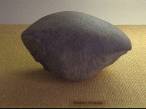I've just found a story from The Times from 7 June 1923 which relates the tale of a meteorite falling on my father's farm in Ashdon, near Saffron Walden in Essex. According to the website there have only been twelve such instances in the last 100 years.

The Natural History Museum at South Kensington has just received a very rare and interesting gift in the shape of a meteorite which fell just before 1 p.m. on March 9 between Saffron Walden and Ashdon, in Essex, on the border of Cambridgeshire. The actual spot is in the parish of Ashdon. The man who saw the meteorite fall was a labourer who states that he heard a loud "sissing" noise and supposed that an aeroplane was overhead. Looking up a second or two after he saw what he thought was a projectile fall about ten to fifteen yards from him, causing the earth to spout up like water. He was much alarmed, because he considered that something had been discharged from a gun. Three days later, in the company with another man, he took the meteorite up from where it had fallen. He says that there was a small hole where it had entered the ground, and this hole increased in width as he dug deeper. The stone was found at a depth of two feet. It often happens that in these cases detonations are heard, but so far as can be ascertained at present, the fall of this meteor was not accompanied by any such explosive noises. The specimen weight about 3lb., and is what is known as a white chrondrite meteoric stone. It is about 5in. long by 4in. wide, and has a thickness of about 3in. in its thickest part. The mass of the stone is composed of minerals belonging to the olivene and pyroxene groups, through which are distributed small particles of nickeliferous iron. The surface of the stone shows with remarkable distinctness the lines of flow of fused material radiated from the centre of the surface, and proves that it was partially fused owing to the high velocity at which it entered the earth's atmosphere. The rarity of the occurrence of a meteor seen to be falling is evident by the fact that only about fifteen falls have been recorded in the British Islands. The museum is indebted for this specimen to the Rev. F. W. Berry, of Wendens Ambo vicarage, near Saffron Walden.
The Min. Mag., 20, p131 (my summary of) Fall 1pm 9 March 1923 observed by Frederich Pratt--thatcher. Location 1/3 mile due S. of All Saints Church Ashdon in 52° 2' 40" N.LAT 0° 18' 20" E. Long. Direction from SW to NE and passed over Saffron Walden. Stone:Reg No 1923,484 wt 1270g original wt. aprox 1300g. dim. 12x9x6cm Composition aprox. 10% magnetic material. F. Pratt working on Ashdon Hall Farm, Ashdon a few feet from the farm road. Author visited on 8th June 1923, depth aprox. 2 feet.
To read more about Ashdon, the idyllic Essex village where I lived for the first 18 years if my life, and where my parents still live, click HERE.



